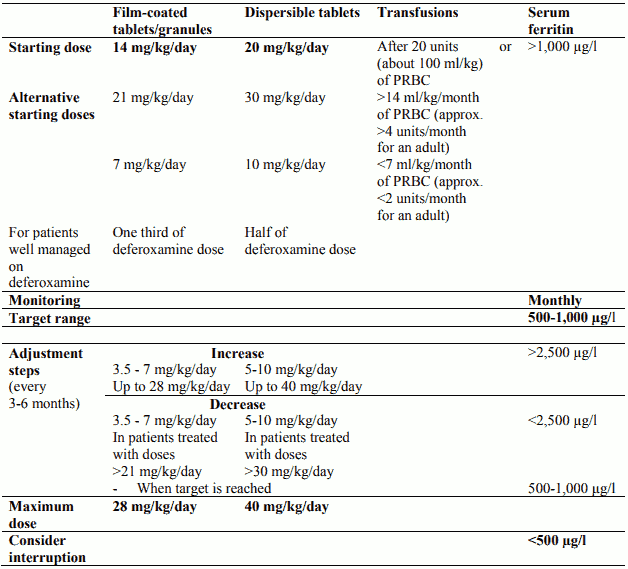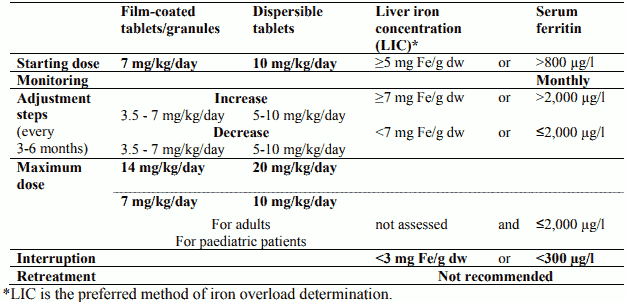EXJADE Dispersible tablet Ref.[2721] Active ingredients: Deferasirox
Source: European Medicines Agency (EU) Revision Year: 2019 Publisher: Novartis Europharm Limited, Vista Building, Elm Park, Merrion Road, Dublin 4, Ireland
Therapeutic indications
EXJADE is indicated for the treatment of chronic iron overload due to frequent blood transfusions (≥7 ml/kg/month of packed red blood cells) in patients with beta thalassaemia major aged 6 years and older.
EXJADE is also indicated for the treatment of chronic iron overload due to blood transfusions when deferoxamine therapy is contraindicated or inadequate in the following patient groups:
- in paediatric patients with beta thalassaemia major with iron overload due to frequent blood transfusions (≥7 ml/kg/month of packed red blood cells) aged 2 to 5 years,
- in adult and paediatric patients with beta thalassaemia major with iron overload due to infrequent blood transfusions (<7 ml/kg/month of packed red blood cells) aged 2 years and older,
- in adult and paediatric patients with other anaemias aged 2 years and older.
EXJADE is also indicated for the treatment of chronic iron overload requiring chelation therapy when deferoxamine therapy is contraindicated or inadequate in patients with non-transfusion-dependent thalassaemia syndromes aged 10 years and older.
Posology and method of administration
Treatment with EXJADE should be initiated and maintained by physicians experienced in the treatment of chronic iron overload.
Posology
Transfusional iron overload
It is recommended that treatment be started after the transfusion of approximately 20 units (about 100 ml/kg) of packed red blood cells (PRBC) or when there is evidence from clinical monitoring that chronic iron overload is present (e.g. serum ferritin >1,000 µg/l). Doses (in mg/kg) must be calculated and rounded to the nearest whole tablet size.
The goals of iron chelation therapy are to remove the amount of iron administered in transfusions and, as required, to reduce the existing iron burden.
Caution should be taken during chelation therapy to minimise the risk of overchelation in all patients (see section 4.4).
In case of switching from film-coated tablets/granules to dispersible tablets, the dose of dispersible tablets should be 40% higher than the dose of film-coated tablets/granules, rounded to the nearest whole tablet.
The corresponding doses for the different formulations are shown in the table below.
Table 1. Recommended doses for transfusional iron overload
Starting dose
The recommended initial daily dose of EXJADE dispersible tablets is 20 mg/kg body weight.
An initial daily dose of 30 mg/kg may be considered for patients who require reduction of elevated body iron levels and who are also receiving more than 14 ml/kg/month of packed red blood cells (approximately >4 units/month for an adult).
An initial daily dose of 10 mg/kg may be considered for patients who do not require reduction of body iron levels and who are also receiving less than 7 ml/kg/month of packed red blood cells (approximately <2 units/month for an adult). The patient's response must be monitored and a dose increase should be considered if sufficient efficacy is not obtained (see section 5.1).
For patients already well managed on treatment with deferoxamine, a starting dose of EXJADE dispersible tablets that is numerically half that of the deferoxamine dose could be considered (e.g. a patient receiving 40 mg/kg/day of deferoxamine for 5 days per week (or equivalent) could be transferred to a starting daily dose of 20 mg/kg/day of EXJADE dispersible tablets). When this results in a daily dose less than 20 mg/kg body weight, the patient's response must be monitored and a dose increase should be considered if sufficient efficacy is not obtained (see section 5.1).
Dose adjustment
It is recommended that serum ferritin be monitored every month and that the dose of EXJADE be adjusted, if necessary, every 3 to 6 months based on the trends in serum ferritin. Dose adjustments may be made in steps of 5 to 10 mg/kg and are to be tailored to the individual patient's response and therapeutic goals (maintenance or reduction of iron burden). In patients not adequately controlled with doses of 30 mg/kg (e.g. serum ferritin levels persistently above 2,500 µg/l and not showing a decreasing trend over time), doses of up to 40 mg/kg may be considered. The availability of long-term efficacy and safety data with EXJADE dispersible tablets used at doses above 30 mg/kg is currently limited (264 patients followed for an average of 1 year after dose escalation). If only very poor haemosiderosis control is achieved at doses up to 30 mg/kg, a further increase (to a maximum of 40 mg/kg) may not achieve satisfactory control, and alternative treatment options may be considered. If no satisfactory control is achieved at doses above 30 mg/kg, treatment at such doses should not be maintained and alternative treatment options should be considered whenever possible. Doses above 40 mg/kg are not recommended because there is only limited experience with doses above this level.
In patients treated with doses greater than 30 mg/kg, dose reductions in steps of 5 to 10 mg/kg should be considered when control has been achieved (e.g. serum ferritin levels persistently below 2,500 µg/l and showing a decreasing trend over time). In patients whose serum ferritin level has reached the target (usually between 500 and 1,000 µg/l), dose reductions in steps of 5 to 10 mg/kg should be considered to maintain serum ferritin levels within the target range and to minimise the risk of overchelation. If serum ferritin falls consistently below 500 µg/l, an interruption of treatment should be considered (see section 4.4).
Non-transfusion-dependent thalassaemia syndromes
Chelation therapy should only be initiated when there is evidence of iron overload (liver iron concentration [LIC] ≥5 mg Fe/g dry weight [dw] or serum ferritin consistently >800 µg/l). LIC is the preferred method of iron overload determination and should be used wherever available. Caution should be taken during chelation therapy to minimise the risk of overchelation in all patients (see section 4.4).
In case of switching from film-coated tablets/granules to dispersible tablets, the dose of dispersible tablets should be 40% higher than the dose of film-coated tablets/granules, rounded to the nearest whole tablet.
The corresponding doses for the different formulations are shown in the table below.
Table 2. Recommended doses for non-transfusion-dependent thalassaemia syndromes
Starting dose
The recommended initial daily dose of EXJADE dispersible tablets in patients with non-transfusion-dependent thalassaemia syndromes is 10 mg/kg body weight.
Dose adjustment
It is recommended that serum ferritin be monitored every month to assess the patient's response to therapy and to minimise the risk of overchelation (see section 4.4). After every 3 to 6 months of treatment, a dose increase in increments of 5 to 10 mg/kg should be considered if the patient's LIC is ≥7 mg Fe/g dw, or if serum ferritin is consistently >2,000 µg/l and not showing a downward trend, and the patient is tolerating the medicinal product well. Doses above 20 mg/kg are not recommended because there is no experience with doses above this level in patients with non-transfusion-dependent thalassaemia syndromes.
In patients in whom LIC was not assessed and serum ferritin is ≤2,000 µg/l, dosing should not exceed 10 mg/kg.
For patients in whom the dose was increased to >10 mg/kg, dose reduction to 10 mg/kg or less is recommended when LIC is <7 mg Fe/g dw or serum ferritin is ≤2,000 µg/l.
Treatment cessation
Once a satisfactory body iron level has been achieved (LIC <3 mg Fe/g dw or serum ferritin <300 µg/l), treatment should be stopped. There are no data available on the retreatment of patients who reaccumulate iron after having achieved a satisfactory body iron level and therefore retreatment cannot be recommended.
Special populations
Elderly patients (≥65 years of age)
The dosing recommendations for elderly patients are the same as described above. In clinical studies, elderly patients experienced a higher frequency of adverse reactions than younger patients (in particular, diarrhoea) and should be monitored closely for adverse reactions that may require a dose adjustment.
Paediatric population
Transfusional iron overload:
The dosing recommendations for paediatric patients aged 2 to 17 years with transfusional iron overload are the same as for adult patients (see section 4.2). It is recommended that serum ferritin be monitored every month to assess the patient's response to therapy and to minimise the risk of overchelation (see section 4.4). Changes in weight of paediatric patients over time must be taken into account when calculating the dose.
In children with transfusional iron overload aged between 2 and 5 years, exposure is lower than in adults (see section 5.2). This age group may therefore require higher doses than are necessary in adults. However, the initial dose should be the same as in adults, followed by individual titration.
Non-transfusion-dependent thalassaemia syndromes:
In paediatric patients with non-transfusion-dependent thalassaemia syndromes, dosing should not exceed 10 mg/kg. In these patients, closer monitoring of LIC and serum ferritin is essential to avoid overchelation (see section 4.4). In addition to monthly serum ferritin assessments, LIC should be monitored every three months when serum ferritin is ≤800 µg/l.
Children from birth to 23 months:
The safety and efficacy of EXJADE in children from birth to 23 months of age have not been established. No data are available.
Patients with renal impairment
EXJADE has not been studied in patients with renal impairment and is contraindicated in patients with estimated creatinine clearance <60 ml/min (see sections 4.3 and 4.4).
Patients with hepatic impairment
EXJADE is not recommended in patients with severe hepatic impairment (Child-Pugh Class C). In patients with moderate hepatic impairment (Child-Pugh Class B), the dose should be considerably reduced followed by progressive increase up to a limit of 50% (see sections 4.4 and 5.2), and EXJADE must be used with caution in such patients. Hepatic function in all patients should be monitored before treatment, every 2 weeks during the first month and then every month (see section 4.4).
Method of administration
For oral use.
EXJADE dispersible tablets must be taken once daily on an empty stomach at least 30 minutes before food, preferably at the same time each day (see sections 4.5 and 5.2).
The dispersible tablets are dispersed by stirring in a glass of water or orange or apple juice (100 to 200 ml) until a fine suspension is obtained. After the suspension has been swallowed, any residue must be resuspended in a small volume of water or juice and swallowed. The tablets must not be chewed or swallowed whole (see also section 6.2).
Overdose
Early signs of acute overdose are digestive effects such as abdominal pain, diarrhoea, nausea and vomiting. Hepatic and renal disorders have been reported, including cases of liver enzyme and creatinine increased with recovery after treatment discontinuation. An erroneously administered single dose of 90 mg/kg led to Fanconi syndrome which resolved after treatment.
There is no specific antidote for deferasirox. Standard procedures for management of overdose may be indicated as well as symptomatic treatment, as medically appropriate.
Shelf life
3 years.
Special precautions for storage
Store in the original package in order to protect from moisture.
Nature and contents of container
PVC/PE/PVDC/Aluminium blisters.
EXJADE 125 mg dispersible tablets: Packs containing 28, 84 or 252 dispersible tablets.
EXJADE 250 mg dispersible tablets: Packs containing 28, 84 or 252 dispersible tablets.
EXJADE 500 mg dispersible tablets: Unit packs containing 28, 84 or 252 dispersible tablets and multipacks containing 294 (3 packs of 98) dispersible tablets.
Not all pack sizes may be marketed.
Special precautions for disposal and other handling
No special requirements.
© All content on this website, including data entry, data processing, decision support tools, "RxReasoner" logo and graphics, is the intellectual property of RxReasoner and is protected by copyright laws. Unauthorized reproduction or distribution of any part of this content without explicit written permission from RxReasoner is strictly prohibited. Any third-party content used on this site is acknowledged and utilized under fair use principles.

